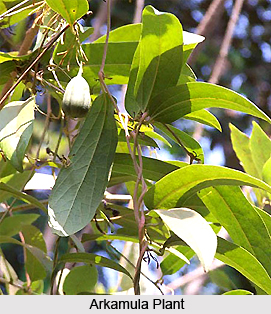 The Indian medicinal plant, Arkamula is widely available in the plains and low hills of the country, usually growing on hedges and bushes of the dry deciduous forests. This plant is biologically known as Aristolochia Indica. Arkamula is called Isarmul, in Bengali, Indian Birthwort in English; Arkamul, Arka-Mula, Nirvel and Ruhimula in Gujarati; Isarmul in Hindi; Gopataputtitoppalu, Ishwarib-alli and Ishwariberu in Kannada. This Indian medicinal plant is also known as Ishwara-Mulli and Karalakam in Malayalam; Kadula, Sampsun and Sapsanda in Marathi, Gopakaroni in Oriya; Garudakkodi, Ichchuramula and Perumkizhangu in Tamil and Dulagooda, Govila, Eswaramuli, Nallaeswari and Thella Usirika in Telugu and Shapesand in Urdu.
The Indian medicinal plant, Arkamula is widely available in the plains and low hills of the country, usually growing on hedges and bushes of the dry deciduous forests. This plant is biologically known as Aristolochia Indica. Arkamula is called Isarmul, in Bengali, Indian Birthwort in English; Arkamul, Arka-Mula, Nirvel and Ruhimula in Gujarati; Isarmul in Hindi; Gopataputtitoppalu, Ishwarib-alli and Ishwariberu in Kannada. This Indian medicinal plant is also known as Ishwara-Mulli and Karalakam in Malayalam; Kadula, Sampsun and Sapsanda in Marathi, Gopakaroni in Oriya; Garudakkodi, Ichchuramula and Perumkizhangu in Tamil and Dulagooda, Govila, Eswaramuli, Nallaeswari and Thella Usirika in Telugu and Shapesand in Urdu.
This perennial climber has greenish-white, ridged stems and long, warped, slightly tuberous roots. The Arkamula leaves are very variable, from linear-oblong to obovate-oblong or sub-pandurate. The leaves are 4-12 cms long and 1.3-7.5 cms wide. The apex is usually obtusely acuminate, entire with somewhat surged margins and the base is cuneate, rounded, truncate or subcor-date. The petioles of Arkamula tree are up to 1.5 cm long.
Arkamula flowers borne singly or in 2-3-flowered axillary racemes; perianth up to 4 cm long with a glabrous pale green inflated, lobed and trumpet-shaped mouth, lip purplish-brown clothed with purple-tinged hairs. The fruits of this Indian medicinal plant are oblong or globose-oblong capsule that is 3-5 cms long, 6-valved; the seeds are deltoid-ovate, acute, flat and winged. The flowers of Arkamula blossom from July to August in central Indian forests.
Arkamula possesses abundance of medicinal properties. The dried roots and occasionally the leaves together are treated as an important conventional Indian drug, known as Iswari in Ayurveda. Ishwari has the power to destroy the toxic effects of all poisons, especially snake poison; moreover it is also used as a gastric stimulant, bitter tonic and emmenagogue. The roots of Arkamula, an Indian medicinal plant, are used, usually in the form of a mixture for the treatment of acute types of dyspepsia, bowel troubles in children and intermittent fevers. In large doses it also heals local irritant, producing nausea, griping pains in the bowels, and sometimes vomiting and tenesmus.
A mixture of the Arkamula roots is considered as a stimulant and febrifuge. Along with black pepper and ginger, it is also used as a carminative for treating diarrhoea and other bowel complaints. The dried, powdered roots of Arkamula are blended with honey to treat leucorrhoea. The tribal inhabitants of eastern Bihar use the root powder mixed with mustard oil as an external application to ease body pain, the ground root of Arkamula is given as a remedy to snake bites, and the mature leaves are chewed to lessen asthma.
The tribal inhabitants of the Surguja District in eastern Madhya Pradesh, the root of Arkamula is mixed with black pepper to treat rheumatism. The leaf juice of Arkamula is used to treat diarrhoea, cholera and recurring fevers. The seeds of this Indian medicinal plant are useful for treating inflammations, biliousness and dry cough. The powdered stem of Arkamula bark is mixed in water with that of Azadirachta Indica and Cassia Fistula and used orally as an antidote for snakebite by the Gonds of northern Andhra Pradesh.



















